Bradford
| Bradford | |
 View towards Bradford city centre |
|
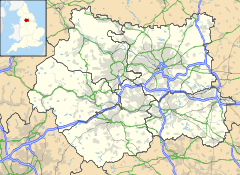 Bradford
|
|
| Area | 24.85 sq mi (64.4 km2) |
|---|---|
| Population | 293,717 [1] |
| - Density | 11,820 /sq mi (4,560 /km2) |
| OS grid reference | |
| - London | 174 mi (280 km) S |
| Metropolitan borough | City of Bradford |
| Metropolitan county | West Yorkshire |
| Region | Yorkshire and the Humber |
| Country | England |
| Sovereign state | United Kingdom |
| Post town | BRADFORD |
| Postcode district | BD1-BD15 |
| Dialling code | 01274 |
| Police | West Yorkshire |
| Fire | West Yorkshire |
| Ambulance | Yorkshire |
| EU Parliament | Yorkshire and the Humber |
| UK Parliament | Bradford North |
| Bradford West | |
| Bradford South | |
| List of places: UK • England • Yorkshire | |
Bradford (pronounced /ˈbrædfərd/ (![]() listen)) lies at the heart of the City of Bradford, a metropolitan borough of West Yorkshire, in Northern England. It is situated in the foothills of the Pennines, 8.6 miles (13.8 km) west of Leeds, and 16 miles (25.7 km) northwest of Wakefield. Bradford became a municipal borough in 1847, and received its charter as a city in 1897. Following local government reform in 1974, city status was bestowed upon the wider metropolitan borough.
listen)) lies at the heart of the City of Bradford, a metropolitan borough of West Yorkshire, in Northern England. It is situated in the foothills of the Pennines, 8.6 miles (13.8 km) west of Leeds, and 16 miles (25.7 km) northwest of Wakefield. Bradford became a municipal borough in 1847, and received its charter as a city in 1897. Following local government reform in 1974, city status was bestowed upon the wider metropolitan borough.
Bradford has a population of 293,717,[1] making it the thirteenth-most populous settlement in the UK. Bradford forms part of the West Yorkshire Urban Area conurbation which in 2001 had a population of 1.5 million[2] and is part of the Leeds-Bradford Larger Urban Zone (LUZ), the third largest in the UK after London and Manchester, with an estimated population in the 2004 Urban Audit of 2.4 million.[3]
Historically a part of the West Riding of Yorkshire, Bradford rose to prominence during the 19th century as an international centre of textile manufacture, particularly wool. It was a boomtown of the Industrial Revolution, and amongst the earliest industrialised settlements, rapidly becoming the "wool capital of the world".[4] The area's access to a supply of coal, iron ore and soft water facilitated the growth of Bradford's manufacturing base, which, as textile manufacture grew, led to an explosion in population and was a stimulus to civic investment; Bradford has fine Victorian architecture including the grand Italianate City Hall.
The textile sector in Bradford fell into a terminal decline from the mid-20th century. Since this time, Bradford has emerged as a tourist destination with attractions such as the National Media Museum and Cartwright Hall. However, Bradford has faced similar challenges to the rest of the post-industrial area of Northern England, including deindustrialisation, housing problems, social unrest and serious economic deprivation.
Since the 1950s Bradford has experienced significant levels of immigration, particularly from Kashmir. Bradford has the second highest proportion of Muslims in England and Wales outside London. An estimated 101,967 people of South Asian origin reside in the city,[5] representing around 20.5% of the city's population, with this figure projected to rise to 28% by 2011.[6] Bradford is often cited as one of the prime examples of 'parallel communities', where the population is effectively segregated along ethnic, cultural and faith lines.[7]
Etymology
The name Bradford is derived from the "broad ford" at Church Bank (below the site of Bradford Cathedral) around which a settlement had begun to appear before the time of the Norman Conquest ("Bradeford" in the Domesday book of 1086). The ford crossed the stream called Bradford Beck.
History
Early history
Bradford was first settled in Saxon times and by the middle ages, had become a small town centred on Kirkgate, Westgate and Ivegate.[8] Destroyed after an uprising in 1070 against the Norman conquest.[9] Bradford grew slowly over the next two-hundred years as the woollen trade gained in prominence. The Civil War caused a decline in the industry but with the accession of William and Mary in 1689 prosperity began to return.[8] The launch of manufacturing in the early 18th century marked the start of the town's development while new canal and turnpike road links encouraged trade.
19th century and the Industrial Revolution
At the turn of the 19th century, Bradford was a small rural market town of 16,000 people, where wool spinning and cloth weaving was carried out in local cottages and farms. The Industrial Revolution led to rapid growth, with wool imported in vast quantities for the manufacture of worsted cloth in which Bradford specialised, and the town soon became known as the wool capital of the world.[10] Yorkshire had plentiful supplies of soft water, which was needed in the cleaning of raw wool, and locally mined coal provided the power that the industry needed. Local Sandstone was an excellent resource for the building of the mills, and with a population of 182.000 by 1850,[11] The city grew rapidly as workers were attracted by jobs in the textile mills.[10] Such unprecedented growth did create problems, however. With over 200 factory chimneys continually churning out black, sulphurous smoke, Bradford gained the reputation of being the most polluted town in England. There were regular outbreaks of cholera and typhoid, and only 30% of children born to textile workers reached the age of fifteen. Life expectancy, of just over eighteen years, was one of the lowest in the country.[12]
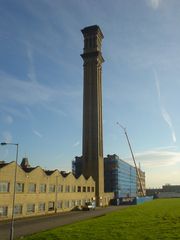
To support the textile mills, a large manufacturing base grew up in the city providing textile machinery, and this led to diversification with different industries thriving side by side.[10] Bradford's manufacturing history includes the Jowett Motor Company, which had many great achievements during its 50 years of existence.[13]
Recent history
The textile industry began to fall into terminal decline in the 20th century. A culture of innovation had been fundamental to Bradford's dominance, with new textile technologies being invented in the city; a prime example being the work of Samuel Lister. This innovation culture continues today throughout Bradford's economy, from automotive (Kahn Design)[14] to electronics (Pace Micro Technology). Wm Morrison Supermarkets was founded by William Morrison in 1899, initially as an egg and butter merchant in Rawson Market, operating under the name of Wm Morrison (Provisions) Limited.[15]
The grandest of the mills (no longer used for textile production) is Lister's Mill, the chimney of which can be seen from most places in Bradford. It has recently become a beacon of regeneration in the city after a £100 million conversion to apartment blocks by property developers Urban Splash.[16]
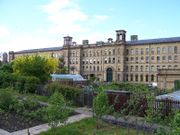
Salts Mill is another large mill that has a new life in the modern era. The mill is occupied by high-technology companies, contemporary design shops and gallery spaces. It is the hub of the world heritage site of Saltaire, three miles (4.8 km) north of the city centre.
By 2001 Bradford had the second largest population of Asians of any UK city, with approximately 68,000 Pakistanis, 12,500 Indians, 5,000 Bangladeshis and 3,000 other Asians. However, the majority of people in the city are white (Ethnicity: 78.3% White, and 18.9% S.Asian). In January 1989, copies of Salman Rushdie's The Satanic Verses were publicly burnt in Bradford, and the city's Muslim community took the lead in the campaign against the book in the UK. In July 2001, ethnic tensions led to serious rioting in Bradford, leading to a report describing Bradford as fragmented[17] and as a city of segregated ethnic communities.[18] Bradford has suffered from deep-rooted de-industrialisation, and has some of the poorest levels of social deprivation in the UK,[19] with widespread pockets of exclusion and rates of unemployment in some wards exceeding 25%.[17]
Governance
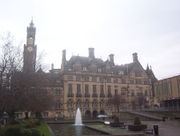
The Metropolitan Borough is divided into 30 Electoral Wards, of which 18 combine to form the Bradford urban area.[20]
These are as follows:
|
|
|
Bradford is represented by three MPs: for the constituencies of Bradford East (David Ward, Liberal Democrat), Bradford South (Gerry Sutcliffe, Labour), and Bradford West (Marsha Singh, Labour). Bradford is within the Yorkshire and the Humber European constituency, which is represented by two Conservative, one Labour, one UKIP, one Liberal Democrat and one BNP MEPs. The voting figures for Bradford in the European Parliament election in June 2009 were: Conservative 24.7%, Labour 22.6%, UKIP 14.9%, Lib Dem 13.4%, BNP 9.4%, Green 8.8%.[21]
The city played an important part in the early history of the Labour Party. A mural on the back of the Priestley Centre For The Arts (visible from Leeds Road) commemorates the centenary of the founding of the Independent Labour Party in 1893.[22]
Geography
Bradford is located at (53.7500, -1.8333)1. Topographically, it is located in the eastern part of the moorland region called the South Pennines.
Unusually for a major city, Bradford is not built on any substantial body of water. The ford from which it takes its name (Broad-Ford) was a crossing of the stream called Bradford Beck. The beck rises in the Pennine hills to the west of the city, and is swelled by tributaries such as Horton Beck, Westbrook, Bowling Beck and Eastbrook. At the site of the original ford, just below the present Bradford Cathedral, it turns north, and flows more or less straight towards the River Aire at Shipley. Bradfordale (or Bradforddale) is a name given by geographers to the valley of Bradford Beck (see for example Firth 1997[1]). It can reasonably be regarded as one of the Yorkshire Dales, though as the site of a big city, it is often not recognised as such.
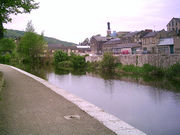
The beck's course through the city centre is entirely underground, and was mostly so by the middle of the 19th century. On the 1852 Ordnance Survey map of Bradford[2] it is visible as far as Sun Bridge, at the end of Tyrrell Street, and then again from beside the railway station at the bottom of Kirkgate. On the 1906 Ordnance Survey,[3] it disappears at Tumbling Hill Street, off Thornton Road, and first appears again north of Cape Street, off Valley Road, though there are further culverts as far as Queens Road. This is substantially the position today.
The Bradford Canal, built in 1774, took its water from Bradford Beck and its tributaries. This supply was often inadequate to feed the locks, and the polluted state of the canal led to its temporary closure in 1866: the canal was closed in the early 20th century as uneconomic. 'The Channel' is another facet of the Alsop plan, envisaging the creation of a new canal-side community through its reopening.
Demographics
As of the 2001 UK census, Bradford had a population of 293,277.[23] There were 106,680 households in Bradford, and the population density was 4,560 inhabitants per square kilometre (11,820/sq mi). For every 100 females, there were 92.9 males.[23] Bradford has the youngest, fastest growing population outside London.[24]
The census showed that 69.3% of Bradford's population was White, 1.9% Mixed Race, 26.1% South Asian, 1.3% Black and 1.4% from other races. 22.1% of the population are of South Asian origin, the highest percentage of South Asian's in a single settlement in England and Wales except in the London Borough of Tower Hamlets. Nearly half of all Asians living in Yorkshire and the Humber live in Bradford, with the central wards of Bradford Moor, City, Little Horton, Manningham and Toller each having large majority Asian populations.[25]
It is forecast that a combination of growing population movement, large-scale immigration and the phenomenon of white flight will mean that no race will hold a demographic majority in Bradford by 2016.[26] Bradford has a large Islamic population, with 16.08% of the wider city identifying themselves as Muslim in the 2001 census.[27] 60.14% were Christians, 1.02% Sikhs, 0.95% Hindus and 13.3% were identified as having no religion. The percentage of Jews, Buddhists and those following other religions each amounted to fewer than 0.5% of the city's population.[27]
The ONS Regional Trends report, published in June 2009, showed that most of Bradford suffers from the highest levels of deprivation in the country.[28][29] Infant mortality stands at double the national average,[30] and life expectancy is considerably lower than in other parts of the district.[31] Bradford has one of the highest unemployment rates in England,[32] with the rate of inactivity amongst Minority Ethnic groups standing at almost 60%.[33][34]
The crime rate in Bradford is significantly higher than the national average.[35] In July 2006, the think tank Reform calculated rates of crime for different offences, relating this to populations of major urban areas (defined as towns over 100,000 population). The study ranked Bradford as the second most dangerous urban area in England and Wales with 98.3 serious offences per 1,000 population, behind Nottingham.[36] Bradford was shown to have the highest level of gun crime in the country, and was amongst the top 5 for incidents of burglary, rape, assault and vehicle crime.[36][37]
Economy
Bradford's traditional textile industry has been in decline for many years. However, Bradford's economy has diversified and the city is now home to several major companies, notably in Finance (Yorkshire Building Society, Provident Financial), Electronics (Pace Micro, Filtronic), Engineering (NG Bailey, Powell Switchgear), Manufacturing (Denso Marston, BASF, Bailey Offsite). Supermarket chain Morrisons has its head office in the Hilmore House in Bradford.[38]
Development
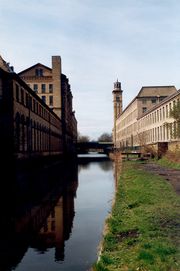
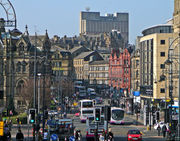
In 2004, the Bradford Urban Regeneration Company commissioned architect Will Alsop to create a vision for the city's future and the role of a "city centre" in the 21st century. The controversial Alsop plan[39] envisaged four regenerated quarters within the heart of the city — The Bowl, The Channel, The Market and The Valley. Each would create new public spaces for commerce, education and leisure and would showcase Bradford's setting within the Pennine region. Many significant developments have been completed, with further large schemes proposed and currently under construction.
A prominent feature of Bradford's cityscape is an abandoned 23 acre building site widely known as The hole. It was intended that this vast empty space would become a shopping centre, though the site has lain empty since 2007 - the anticipated opening date. Demolition of existing buildings to make way for the project took place in 2004. Although little work on the site had taken place in the interim, in 2008 developers Westfield halted the project indefinitely, blaming the recession, but critics accuse the company of making unmanageable promises[40] and the council of a lack of vision.[41] Poetry and art now adorns the fence of the site, lamenting the effect the hole has had, and continues to have, on Bradford and its people.[42]
Projects that have been completed include:
- Centenary Square, city centre, public piazza and retail.
- Lister's Mill redevelopment, Manningham.
- Bradford centre termination of M606.
- Leisure Exchange.
- Valley Parade, Bradford City's 25,000 capacity all-seater stadium.
- Manchester Road corridor, a 2-mile (3.2 km) guided bus route with innovative art installation/bus stops.
- Rawson Quarter, redevelopment of the former Rawson Market.
- The Gatehaus,[43] and Eastbrook Hall, Little Germany,
Landmarks
Bradford's oldest building is the cathedral, which for most of its life was a parish church. Few other Medieval buildings have survived apart from Bolling Hall, which has been preserved as a museum.
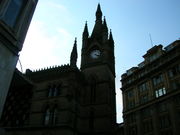
There are some fine Victorian buildings: apart from the abundance of mills, there is the City Hall (with statues of rulers of England unusually including Oliver Cromwell), the former Wool Exchange, and a large Victorian cemetery at Undercliffe. Little Germany is a splendid Victorian commercial district just east of the city centre which takes its name from 19th century immigrants who ran businesses from some of the many listed buildings. Following decades of decay there have been successful conversions to office and residential use. In mid-2005 renovation began on the prominent Eastbrook Hall in Little Germany. Bradford also has a number of architecturally historic hotels that date back to the establishment of the two railway lines into the city centre, back in Victorian times. The Victoria Hotel and the Midland Hotel were built to accommodate business travellers to the city during the height of the woollen trade.
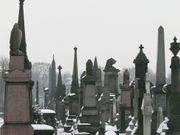
Like many cities, Bradford lost a number of notable buildings to developers in the 1960s and 1970s: particularly mourned at the time were the Swan Arcade and the old Kirkgate Market. In recent years some buildings from that era have themselves been demolished and replaced: Provincial House, next to Centenary Square, was demolished by controlled explosion in 2002,[44] and Forster House was pulled down in 2005 as part of the Broadway development.
Bradford's main art gallery is housed in the grand Edwardian Cartwright Hall in Lister Park. The National Media Museum celebrates cinema and movies, and is the most visited museum outside London. It contains an Imax cinema, the Cubby Broccoli Cinema, and the Pictureville Cinema — described by David Puttnam as the best cinema in Britain.[45]
Also in the city is The St George's Hall - a grand concert hall dating from 1853. The former Odeon cinema was the recent focus of protests by Bradfordians who did not wish to see the old building close. Adjacent is the Alhambra theatre, built in 1914 for theatre impresario Frank Laidler, and later owned by the Moss Empire group (Oswald Stoll and Edward Moss). The theatre was refurbished in 1986.
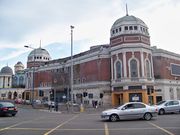
Memorials
|
|
Transport
In past centuries Bradford's location in Bradfordale made communications difficult, except from the north. Nonetheless, Bradford is now well-served by transport systems. Bradford was first connected to the developing turnpike network in 1734, when the first Yorkshire turnpike was built between Manchester and Leeds via Halifax and Bradford.
Today Bradford lies on several trunk roads:
- The A647 between Leeds and Halifax, via Queensbury
- The A650 between Wakefield and Keighley
- The A658 to Harrogate
- The A6036 to Halifax via Shelf
The M606, a spur off the M62 motorway, connects Bradford with the national motorway network. Although it was originally planned to go directly into the city centre, this has never been built and is unlikely now ever to be, as a hotel has been built across the proposed route.
Bradford's tram system was begun by Bradford Corporation in 1882. At first the vehicles were horse-drawn but were replaced by steam-driven trams in 1883, and by electric ones in 1898. On 20 June 1911, Britain's first trolleybus service opened in Bradford, between Laisterdyke and Dudley Hill. The last service in Bradford — and indeed in Britain — ceased operation on 26 March 1972. Ten Bradford trolleybuses are now preserved at the Trolleybus Museum at Sandtoft, Lincolnshire.[46] In 1974 Bradford's municipal buses were taken over by the West Yorkshire Metro. First Bradford and Arriva are now the chief operators of buses in Bradford, with some routes using guided buses.
The Bradford Canal was a 4-mile (6.4 km) long spur off the Leeds and Liverpool Canal at Shipley. It was planned and built as part of the original Leeds and Liverpool project, to connect Bradford with the limestone quarries of north Yorkshire, the industrial towns on both sides of the Pennines and the ports on each coast. It opened in 1774, closed in 1866, reopened in 1871, and finally closed in 1922. There are plans to rebuild the canal as a key part of the regeneration of the city centre (see the main article).
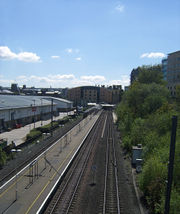
The Leeds and Bradford Railway opened Bradford's first railway station on 1 July 1846. It offered a service via Shipley to Leeds. The station was rebuilt in the early 1850s and again, in 1890. Today it is a smaller railway station dating from 1990, called Forster Square railway station though it is somewhat distant from Forster Square itself.
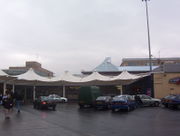
The Lancashire and Yorkshire Railway opened its station at Drake Street on 9 May 1850, on its line between Manchester and Leeds. The Great Northern Railway opened a third terminus at Adolphus Street to serve Leeds and places on its network in 1854, but the station was located too far from the centre, and the two companies eventually agreed to build a joint station to replace the L&Y's station at Drake Street. This station was named Bradford Exchange railway station, and opened in 1867.[47] Adolphus Street remained as a goods terminal. By 1973, The Exchange Station was deemed too large and was rebuilt on a different site. In 1983 that station was renamed Bradford Interchange when a large bus station was built alongside. Both Forster Square and Bradford Interchange stations are under the control of the West Yorkshire Metro as part of the Leeds-Bradford Line routes.
There have been many schemes to build a link between Bradford's main railway terminals, but none has ever come to fruition. The major redevelopment of the city centre in the 1960s provided an opportunity to connect the two termini but this was not pursued. A limitation currently exists with such a connection in that large buildings were constructed on the alignment in the 1990s. The main practical difficulty in connecting the termini is the great difference in elevation: the Interchange station is already at the bottom of a long slope, steep by railway standards, but is still many feet higher than Forster Square Station. However, this gradient is not unprecedented in railway construction terms and the relocation of Forster Square Station further from the city centre has provided additional space in which the transition could be accomplished.
Some bus services, such as the MetroConnect services to Leeds Bradford International Airport, call at both stations, and a zero-fare bus service funded by Bradford council and Metro was launched in September 2008.[48][49]
Bradford is served by Leeds Bradford International Airport, 6 miles (9.7 km) to the north east of the city. Bradford and Leeds councils jointly opened the airport in 1931. There has been rapid expansion in recent years, and is the home base of economy Airline Jet2.com. In May 2007 the joint councils sold the airport to Bridgepoint Capital for £145.5 million. Bridgepoint announced that a further £70 million would be invested in airport improvements, to boost passenger figures to over 7 million by 2015.[50] The airport has recently announced a new long-haul route to Islamabad using wide-bodied Airbus A310 aircraft. It is hoped this spurs on new routes from the airport.[51]
Education
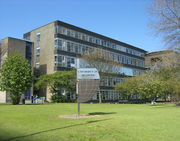
The University of Bradford which has over 10,000 students received its Royal Charter in 1966, but traces its history back to the 1860s. It has always been a technical and technological institution, and has no true arts faculties; yet it still covers a wide range of subjects including technology & management science, optometry, pharmacy, medical sciences, nursing studies, archaeology and modern languages. Its Peace Studies Department, founded with Quaker support in 1973, was for a long time the only such institution in the UK.
In terms of nationally recognised leading areas of research there are various departments such as Institute of Pharmaceutical Innovation, Institute of Cancer Therapeutics, Bradford School of Pharmacy, Peace Studies, Archaeology, Engineering, Management, Biochemistry, amongst others. The university balances academic research and teaching quality with a strong tradition of social inclusion.
University of Bradford School of Management located near Lister Park, in 2008, was rated the 11th best business school in the UK by the Financial Times[52] and 21st best by The Economist.[53]
Bradford College has around 26,000 students. It developed from the 19th century technical college whose buildings it has inherited. It now offers a wide range of further and higher educational courses, and is an Associate College of Leeds Metropolitan University. It has absorbed the Art School whose most famous alumnus is David Hockney.
Culture and recreation
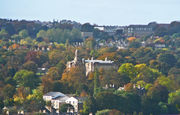
Bradford's main art gallery is housed in the grand Edwardian Cartwright Hall in Lister Park. Salts Mill, in nearby Saltaire, has the world's largest collection of David Hockney artworks. Bradford Industrial Museum[54] celebrates and explains the significant achievements in Bradford's industrial past, from textiles to the manufacture of motor cars. Colour was important in the development of the textile industry and the educational Bradford Colour Museum[55] is unique in the UK. It is run by the Society of Dyers and Colourists.
The National Media Museum celebrates cinema and movies, and is the most visited museum outside London. It contains an Imax cinema, the Cubby Broccoli Cinema, and the Pictureville Cinema — described by David Puttnam as the best cinema in Britain.[45] The museum has a rich and varied programme of films from around the world. Bradford's contribution to the world of film has been recognised internationally as it became UNESCO's first City of Film in 2009.[56]
Traditional cinemas have been replaced by vast entertainment complexes with multi-screen cinemas. The Leisure Exchange in the city centre is home to a 16 screen Cineworld and at Thornbury, on the outskirts of Bradford, stands the Odeon Leeds-Bradford with 13 screens. The latter replaced the old Odeon next to the Alhambra which is the continuing focus of protests by Bradfordians who do not wish to see the old building demolished.[57] The University of Bradford also has a cinema run by the Students' Union, operating from the University's Great Hall.[58]
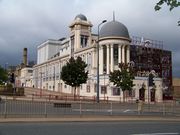
There are four theatres in Bradford: aside from The Alhambra, there is a smaller Studio theatre in the same complex. Both of these are operated by City of Bradford Metropolitan District Council. The Theatre in the Mill is a small studio theatre at the University of Bradford which presents both student and community shows and small-scale touring professional work. The Priestley Theatre is a privately run venue with a medium-sized proscenium theatre and a small studio.
Among the professional theatre companies based in Bradford are Kala Sangam, the satirical madcap comedy troop, Komedy Kollective, Lost Dog (based at Theatre In The Mill) and Mind the Gap, one of the longest established, who have always worked with a mixture of disabled and able-bodied performers. Groups and organisations teaching theatre include The Asian Theatre School, Bradford Stage and Theatre School and Stage 84. There are also a number of amateur theatre groups.
St George's Hall is a grand concert hall dating from 1853. The Hallé Orchestra have been regular visitors over the years, as have a wide range of popular musicians, bands, entertainers and comedians. It is sometimes used for theatrical productions. Although Bradford was home to composer Frederick Delius, there are currently no prominent professional music ensembles based in Bradford, though there are some prominent amateur groups such as the Bradford Festival Chorus.
Bradford is the birthplace of rock bands New Model Army, Anti System, Smokie, Southern Death Cult/The Cult, The Scene, One Minute Silence, Terrorvision and Asian hip hop group Fun-Da-Mental.
Each year Bradford hosts several successful festivals. The Bradford Mela,[59] the biggest of its kind outside Asia, takes place in June. Bradford is also known for its various film festivals hosted by the National Media Museum. These include The Bradford Film Festival in March, Bite The Mango Film Festival (World Cinema) in September, plus the Bradford Animation Festival held each November. The city council also organises annual music festival Bingley Music Live held in nearby Bingley.
Nightlife in Bradford has traditionally centred around Manor Row and Manningham Lane. More recently, several clubs and pubs have opened in the West End of Bradford, around the Alhambra Theatre, turning what was previously a fairly quiet area into one that is often crowded and raucous at night.
Within the city district there are 37 parks and gardens. Lister Park, with its boating lake and Mughal Water Gardens, was voted Britain's Best Park for 2006.[60] Peel Park is the venue for the annual Mela — a celebration of eastern culture, and Bowling Park in East Bowling is the site where the annual Bradford Carnival takes place, celebrating local African and Caribbean culture. Beauty spot, Chellow Dene, has two Victorian reservoirs set in pleasant woodland. To the west and north of Bradford are picturesque and atmospheric moorlands: the famous Ilkley Moor and moors above Haworth known internationally for its connection with the Brontë sisters.
Bradford was one of the first areas of the UK to get a local commercial radio station Pennine Radio in September 1975. Today this is The Pulse of West Yorkshire and Pulse Classic Gold. As of 2006[update] Bradford Community Broadcasting based in the city centre has broadcast on full-time Community Radio license around Bradford and the Aire Valley, whilst the University radio station Ramair broadcasts to the student population. Bradford's only Television station AAP TV caters for Bradford's large Asian community. The Telegraph and Argus is Bradford's daily newspaper, published six days each week from Monday to Saturday.
Sport
Bradford has a long sporting tradition, and Bradford Bulls (formerly Bradford Northern) are one of the most successful rugby league clubs in the world, winning the World Club Championship three times since 2002 and also seven times winners of the Rugby Football League Championship. The home of the Bulls is Grattan Stadium, Odsal (formerly Odsal Stadium) to the south of the city. The city is also home to a number of rugby union clubs — Bradford and Bingley RFC (The Bees) are based in Bingley; Bradford Salem are based in the Heaton area and Wibsey RFC can be found to the south of the city centre. The Richard Dunn Sports Centre is located close to the Odsal and the sports facilities at the university are also open to the public at certain times.
League football was introduced to West Yorkshire in Bradford, when Bradford City were formed in 1903. James Whyte, a sub-editor of the Bradford Observer had met with Football Association representative John Brunt in January to discuss the plans, and in May, Manningham RFC, a rugby league side decided to change codes to association football.[61] The Football League subsequently elected Bradford City to the league, with a total of 30 votes to replace Doncaster Rovers,[62] because it saw the invitation as a chance to introduce football to the rugby-dominated county.[63] Just eight years after they were elected to the league, City won the FA Cup and recorded the highest league position in their history.[64] The club now plays in the bottom tier of The Football League following two periods of administration,[65][66][67] but their ground suffered one of the worst all-time sporting disasters in the world after 56 people died at Valley Parade on 11 May 1985.[68] A second side from the city, Bradford Park Avenue were successful in The Football League until they dropped out of the Football League in 1970. They now play in the Northern Premier League, which means the Bradford derby has not been played in years. Their ground hosted county cricket for Yorkshire as well as football.
Bradford was once home to the now-defunct Bradford Dukes speedway team, which raced at Odsal. Speedway was staged at Greenfields Stadium in the pioneer days, when it was known as the Autodrome, and it was used for a couple of seasons in the early 1960s. Odsal opened its doors soon after the war in Europe ended in 1945 and continued in the late 1950s. It entered a team in the 1960 Provincial League then fell dormant until the 1970s when it re-opened and ran for many years. The track staged a number of big meetings including Speedway World Finals. The speedway team rode under a number of names - probably the longest running was Bradford Northern - in common with the Rugby League team at the same venue. This was changed after years of decline to Bradford Barons - emulating the more successful Halifax Dukes. Eventually the Halifax team was brought to Bradford under the name Bradford Dukes.
Religion
The most prominent Christian church in Bradford is Bradford Cathedral, originally the Parish Church of St Peter. The parish of Bradford was in existence by 1283, and there was a stone church on the shelf above Bradford Beck by 1327. The Diocese of Bradford was created from part of the Diocese of Ripon in 1919, and the church became a cathedral at that time.
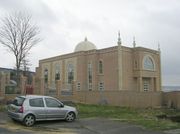
With such a significant Pakistani population, Islam has become prominent throughout Bradford. This is particularly the case in inner city areas such as Manningham, where a majority of the population are Muslim.[69] Accordingly, there are a substantial number of mosques. Some were converted from churches or other buildings, but there are also several that have been purpose-built. The largest of these is the Hanfia Masjid in Manningham. Another large mosque in Bradford is the Al Mahdi Mosque of the Ahmadiyya Muslim Community and the Madni Jamia Masjid which recently won the Model Mosque (Islam Channel) award.
The city also has a sizeable Indian immigrant community, and there are a significant number of Hindus in the area. The Lakshmi Narayan mandir opened officially on 20 April 2008[70] and is the largest Hindu temple in Northern England.[71] Also in Bradford is the Hindu Temple and Community Centre on Thornton Lane.[72] There are also smaller house-based mandirs, as shown in the List of Hindu Temples.
There is also a prominent Sikh community in Bradford, with six gurudwaras (Sikh places of worship) around the city. The Sikh festival of Vaisakhi (alternative spelling of Baisakhi) is also celebrated on 14 April every year, this sees Sikhs from Bradford and the surrounding area travel to each of the gurudwaras in the city in a procession called a nagar kirtan. There are three gurudwaras in the Leeds Road area of Bradford alone, Gobind Singh Gurudwara, on Gobind Marg, being the largest of these. There is a Ramgharia Gurudwara on Bolton Road and Guru Nanak Gurudwara is on Wakefield Road.
Over the years, most of the Jewish population have migrated to Leeds. The Jewish community in Bradford was strong in the middle to late 19th century, and there is a 19th century Reform synagogue in Bowland Street in the Manningham area. This, "The oldest Reform synagogue outside London",[73] was established by German Jews who had moved to Bradford for the wool trade. According to historian Shatman Kadish, "The city of Bradford was unique in that it boasted a Reform synagogue before it acquired an Orthodox one".[74]
The district has a tradition of nonconformity which is reflected in the number of chapels erected by Congregationalists, Baptists, Methodists etc. The city was a major centre of the House Church movement in the 1980s, and the Christian charity Christians Against Poverty was founded in the city. Other house churches in the city include El Shaddai International Christian Centre and the World Outreach Church. Bradford is also home to the Abundant Life Church, a large nonconforming Church, that has around 3,000 members.[75]
Two carved stones, probably parts of a Saxon preaching cross, were found on the site of Bradford Cathedral. They indicate that Christians may have worshipped here since Paulinus of York came to the north of England in AD 627 on a mission to convert Northumbria. He preached in Dewsbury and it was from there that Bradford was first evangelised. The vicars of Bradford later paid dues to that parish.
Public services
There are two major hospitals in Bradford: Bradford Royal Infirmary and St Luke's Hospital.
Bradford is the focus of one of the UK's largest ever birth cohort studies, known as Born in Bradford. Partly supported by European funding, it is the result of close collaboration between the University of Bradford, the NHS and other institutions in West Yorkshire. It will track the lives of all the babies born in the city from 2006 to 2008 and aims to find solutions to some of Bradford's public health problems, such as obesity and a high infant mortality rate.
Crime
In a 2006 study by the think tank Reform into urban crime rankings, Bradford was ranked the second most dangerous city in England and Wales. The city was shown to have the highest level of gun crime of all the cities surveyed;[37] Bradford was shown to have the second highest rate of assaults per 1000 population, as well as the second highest rate of burglary offences, at over double the national average. The city had the fifth highest rate of vehicle crime and rape offences. Bradford also had the eighth highest murder rate of the 55 cities studied.[36] Bradford, has also been the scene of many high profile crimes, such as the shooting of PC Sharon Beshenivsky when she responded to a burglary at a travel agents in the city centre.[76] In May 2010, Stephen Griffiths, the self proclaimed 'Crossbow Cannibal' was charged with the murders of 3 prostitutes in the Bradford area, with some of the victims body parts found in the local River Aire.[77]
Bradford has also witnessed two serious riots in the past 15 years:
Manningham Riots
The Manningham Riot was a short but intense period of rioting which took place from 10 to 12 June 1995, in the district of Manningham in Bradford.
A series of widely publicised riots and racial disturbances have occurred in this part of Bradford since the mid 1990s, which have often been attributed to the segregation that has been identified between the various ethnic groups present in the city. The riot of summer 1995 was limited to a relatively confined area of the city, but was seen as indicative of the circumstances which led to the later and more widespread riot of summer 2001.
Bradford Riots
The Bradford Riots were a short but intense period of rioting which began on 7 July 2001, in Bradford, West Yorkshire, England. It occurred as a result of heightened tension between ethnic minority communities and the city's white majority, stoked by confrontation between the Anti-Nazi League and far right groups such as the National Front.[78][79] Similar race riots had occurred a few days earlier in other parts of northern England.
More than 300 police officers were hurt during the riot. There were 297 arrests in total; 187 people were charged with riot, 45 with violent disorder and 200 jail sentences totalling 604 years were handed down, the most ever handed out for public disturbance by some margin.[80] The last rioter was sentenced six-and-a-half years after the events; the number of convictions for riot was unprecedented in English legal history. In fact, the next highest amount was 5 for an investigation in London. The estimated damage was put at £7 million. The government subsequently commissioned the Cantle report which made 67 recommendations. In 2006 Channel 4 produced a TV fictional drama based loosely on the riots from the perspective of an Asian family.
Notable Bradfordians
Only a few particularly notable names are listed here. See Category:People from Bradford for a fuller list The people in this list were either born or brought up in Bradford (not necessarily both), or had a significant connection with the city later in life. Those marked with an asterisk ('*') are described in Lister, 2004.[4]
- Sir Edward Appleton – Discoverer of the ionosphere and Nobel Prize winner.
- The Brontë sisters, Anne, Emily*, and Charlotte* – born in Thornton on the outskirts of Bradford, but later lived in Haworth.
- Joe Johnson World snooker champion (1986) and finalist in 1987.
- Kiki Dee – Born Pauline Matthews – famous for her duet with Elton John, Don't go breaking my heart.
- Frederick Delius – Composer.
- Fabian Delph – footballer for Aston Villa F.C.
- Joolz Denby – Poet and novelist.
- W.E. Forster MP for Bradford – Commemorated by statue, and is the namesake of Forster Square.
- Peter Firth – Actor who appeared in Here Come the Double Deckers.
- Gareth Gates – Singer.
- Barbara Jane Harrison - Air stewardess who was awarded the George Cross for heroism, was born in Bradford.
- David Hockney – Artist.
- Allan Holdsworth - Jazz Guitarist.
- Chris Norman – Singer.
- Benjamin and William Jowett – Car manufacturers and inventors.
- Samuel Lister – Industrialist and inventor, commemorated by a statue.
- Joel York member of Pittsburgh. (USA) based band Gramsci Melodic
- Brian Noble - Crusaders RL head coach and former Bradford Bulls, Wigan Warriors & Great Britain head coach.
- Richard Oastler – Social reformer; statue in Northgate.
- Nikki Patel - Coronation Street actress.
- Edward Petherbridge - Television, film and theatre actor. Notable for playing Lord Peter Wimsey in the televised adaptations of Dorothy L. Sayer's novels.
- Albert Pierrepoint – Famous British executioner.
- Anthony Price - Fashion designer, working relationships with Roxy Music, Bryan Ferry, David Bowie and Topman.
- J. B. Priestley – Writer, commemorated by a statue.
- Sarah-Jane Potts – Actress.
- Andrew-Lee Potts – Actor.
- Michael Rennie – Actor.
- RDB (Rhythm Dhol Bass) – Punjabi (Indian) bhangra group.
- Tony Richardson – Academy award winning film director and producer.
- Simon Rouse – actor.
- James Sammon A.K.A Pianoman - Music producer and song writer.
- Justin Sullivan – Musician and lyricist; lead singer and founder of Bradford-based cult rock band New Model Army.
- Peter Sutcliffe – Serial killer
- Benson Taylor – Composer.
- Mike Turner – Musician and producer; former lead guitarist of Canadian Alternative band Our Lady Peace.
- Kimberley Walsh – Member of Girls Aloud.
- Sally Walsh – Sister of Girls Aloud Member Kimberley Walsh also an Actress who is most famous for playing Lyn Hutchingson in popular TV show Emmerdale.
- Timothy West – Actor and president of the London Academy of Music and Dramatic Art.
- Richard Whiteley – Television presenter.
- Junior Witter – Professional boxer.
In popular culture
In the BBC political satire The Amazing Mrs Pritchard, the Prime Minister considers a proposal to move Parliament to Bradford, as it is closer to the geographic centre of the country than London. The Buttershaw area of the city featured in the 1986 film Rita, Sue and Bob Too, in which two 16-year-old girls were involved in a love triangle with a wealthy married man (played by George Costigan). The film was created by Andrea Dunbar, who died four years after it was made. It was initially unpopular with local residents due to its negative image of the area, but has since earned itself a good reputation in the local community as Buttershaw's claim to fame.[81][82]
Bradford features in the 1983 film Monty Python's The Meaning of Life with footage filmed in Lister Park.[83] The new Spooks spin-off for BBC Three, Spooks: Code 9 was filmed in Bradford.[84]
Bradford is also in the film East is East. Oak Lane is shown in the film when the family go to Bradford to visit Mr.Shahand his family.[85]
International relations
Bradford is twinned with a number of places around the world:[86]
 Skopje, Macedonia (since 1963)
Skopje, Macedonia (since 1963) Roubaix, France (since 1969)
Roubaix, France (since 1969).svg.png) Verviers, Belgium (since 1970)
Verviers, Belgium (since 1970) Mönchengladbach, Germany (since 1971)
Mönchengladbach, Germany (since 1971) Galway, Ireland (since 1987)
Galway, Ireland (since 1987) Mirpur, Pakistan (friendship agreement in 1998)
Mirpur, Pakistan (friendship agreement in 1998)
See also
- Bradford City stadium fire
References
- ↑ 1.0 1.1 "KS01 Usual resident population: Census 2001, Key Statistics for urban areas". Statistics.gov.uk. 2004-08-05. http://www.statistics.gov.uk/StatBase/ssdataset.asp?vlnk=8271&Pos=2&ColRank=1&Rank=224. Retrieved 2010-02-02.
- ↑ National Statistics (2005). "Focus on people and migration: chapter 3 The UK's major urban areas". p. 47. http://www.statistics.gov.uk/downloads/theme_compendia/fom2005/03_FOPM_UrbanAreas.pdf. Retrieved 2007-10-20.
- ↑ "Urban Audit - City Profiles: Leeds". Urban Audit. http://www.urbanaudit.org/CityProfiles.aspx?CityCode=UK003C&CountryCode=UK. Retrieved 2009-01-29.
- ↑ "History of Bradford". visitbradford.com. http://www.visitbradford.com/leisure-attractions/history-of-bradford.asp. Retrieved 2008-04-23.
- ↑ Neighbourhood Statistics. "Check Browser Settings". Neighbourhood.statistics.gov.uk. http://www.neighbourhood.statistics.gov.uk/dissemination/LeadKeyFigures.do?a=3&b=276807&c=BRadford&d=13&e=13&g=379385&i=1001x1003x1004&o=254&m=0&r=1&s=1242686885322&enc=1. Retrieved 2010-02-02.
- ↑ Smithard, Tom. "Fascism and Islamism thrive in Bradford - report". Yorkshire Post. http://www.yorkshirepost.co.uk/news/Fascism-and-Islamism-thrive-in.3810805.jp. Retrieved 2010-02-02.
- ↑ "Kenan Malik's essay on the real value of diversity". kenanmalik.com. http://www.kenanmalik.com/essays/diversity.html. Retrieved 28 August 2010.
- ↑ 8.0 8.1 "History of Bradford". Visitbradford.com. http://www.visitbradford.com/leisure-attractions/history-of-bradford.asp. Retrieved 2010-02-02.
- ↑ "Bradford". Tiscali.co.uk. 1960-10-01. http://www.tiscali.co.uk/reference/encyclopaedia/hutchinson/m0017974.html. Retrieved 2010-02-02.
- ↑ 10.0 10.1 10.2 "Bradford's History - Bradford University School of Management". Brad.ac.uk. http://www.brad.ac.uk/acad/management/external/page.php?section=bradford&page=bradhistory. Retrieved 2010-02-02.
- ↑ "Bradford - Hutchinson encyclopedia article about Bradford". Encyclopedia.farlex.com. http://encyclopedia.farlex.com/Bradford. Retrieved 2010-02-02.
- ↑ "Bradford". Spartacus.schoolnet.co.uk. http://www.spartacus.schoolnet.co.uk/ITbradford.htm. Retrieved 2010-02-02.
- ↑ Ken Baker. "British Motor Manufacturers 1894-1960, Jowett". Britishmm.co.uk. http://www.britishmm.co.uk/history.asp?id=506. Retrieved 2010-02-02.
- ↑ "Kahn Design | Alloy Wheels - Car Conversions - Watches". Kahndesign.com. http://www.kahndesign.com/. Retrieved 2008-09-19.
- ↑ "Welcome To Morrisons" (PDF). http://www.ngfl-cymru.org.uk/vtc/ngfl/bus_studies/13/company_info_unit_two/student_pack_morrisons.pdf. Retrieved 2010-02-02.
- ↑ "Getting Ready To Raise Roof At Mill!". Telegraph & Argus. Newsquest Media Group. 18 August 2006. http://archive.thetelegraphandargus.co.uk/2006/8/18/187550.html. Retrieved 2008-09-18.
- ↑ 17.0 17.1 Fairuk.org
- ↑ Herbert, Ian (2001-07-10). "'Unacceptable segregation' in Bradford - This Britain, UK". London: The Independent. http://www.independent.co.uk/news/uk/this-britain/unacceptable-segregation-in-bradford-677294.html. Retrieved 2010-02-02.
- ↑ "Indices of Deprivation 2004" (PDF). http://www.bradford.gov.uk/NR/rdonlyres/B48020C9-38F1-4697-8BDE-1CDB96CE7E3B/0/IndexofDeprivationBradfordReport.pdf. Retrieved 2010-02-02.
- ↑ Bradford.gov.uk
- ↑ Rogers, Simon (10 June 2009). "Eaxctly how well did the BNP do where you live?". Guardian: Data Blog (London). http://www.guardian.co.uk/news/datablog/table/2009/jun/09/european-elections-elections-2009. Retrieved 2009-07-14.
- ↑ "bradford: city for peace/site12-14". Cityforpeace.org.uk. http://www.cityforpeace.org.uk/htdocs/site12-14.html. Retrieved 2010-02-02.
- ↑ 23.0 23.1 www.statistics.gov.uk/census2001/downloads/1991_ua.xls
- ↑ "Invest in the UK | Invest in Yorkshire | Invest in Bradford". Invest in Yorkshire. http://www.investinyorkshire.com/Key-Locations/Bradford.aspx. Retrieved 2010-02-02.
- ↑ "BCSP Maps & Stats". Bcsp-web.org. http://www.bcsp-web.org/mapguide_site/maingeo.cfm. Retrieved 2010-02-02.
- ↑ Timesonline.co.uk
- ↑ 27.0 27.1 Neighbourhood Statistics. "Check Browser Settings". Neighbourhood.statistics.gov.uk. http://www.neighbourhood.statistics.gov.uk/dissemination/LeadTableView.do?a=7&b=276807&c=bradford&d=13&e=16&g=379385&i=1001x1003x1004&o=35&m=0&r=1&s=1250535306322&enc=1&dsFamilyId=95. Retrieved 2010-02-02.
- ↑ "Bradford one of most deprived cities in region (From Bradford Telegraph and Argus)". Thetelegraphandargus.co.uk. 2009-06-25. http://www.thetelegraphandargus.co.uk/news/4457556.District_s_Haves_and_Have_Nots_revealed/?action=complain&cid=7789328. Retrieved 2010-02-02.
- ↑ Statistics.gov.uk
- ↑ Dent, Emma (2008-01-28). "Born in Bradford project takes on infant mortality | Resource centre | Health Service Journal". Hsj.co.uk. http://www.hsj.co.uk/born-in-bradford-project-takes-on-infant-mortality/442131.article. Retrieved 2010-02-02.
- ↑ Bradfordairedale-pct.nhs.uk
- ↑ "Accent Community Partnerships, Bradford". Showcase.hcaacademy.co.uk. http://showcase.hcaacademy.co.uk/case-study/accent-community-partnerships-bradford.html#background. Retrieved 2010-02-02.
- ↑ "Bradford District" (PDF). http://www.westyorkshireeconomicpartnership.org.uk/NR/rdonlyres/C02E32CD-AF2F-477E-9E57-3E0FE9EF9DD5/0/SEA_District_SummariesJan_2007.pdf. Retrieved 2010-02-02.
- ↑ Communities.gov.uk
- ↑ "Bradford Crime Statistics & Policing | Local Crime Rates & Stats". UpMyStreet. http://www.upmystreet.com/local/crime-in-bradford.html. Retrieved 2010-02-02.
- ↑ 36.0 36.1 36.2 "Urban crime rankings". Reform.co.uk. 2006-02-02. http://www.reform.co.uk/Research/CriminalJustice/CriminalJusticeArticles/tabid/113/smid/378/ArticleID/636/reftab/74/t/Urban%20crime%20rankings/Default.aspx. Retrieved 2010-02-02.
- ↑ 37.0 37.1 "UK | Crime 'hotspot' study angers city". BBC News. 2006-05-23. http://news.bbc.co.uk/1/hi/uk/5006852.stm. Retrieved 2010-02-02.
- ↑ "Contact Us." Morrisons. Retrieved on 20 June 2010.
- ↑ Bradfordurc.co.uk
- ↑ "Westfield standstill ‘choking’ Bradford | News". Retail Week. 2009-03-27. http://www.retail-week.com/westfield-standstill-choking-bradford/2013310.article. Retrieved 2010-02-02.
- ↑ "Mystery poet vents frustrations on Westfield hoarding (From Bradford Telegraph and Argus)". Thetelegraphandargus.co.uk. 2009-04-05. http://www.thetelegraphandargus.co.uk/news/4267369.Bard_of_Broadway_laments_the_delay/. Retrieved 2010-02-02.
- ↑ "non-brewed condiment's Photostream". Flickr. http://www.flickr.com/photos/23038067@N08/page2/. Retrieved 2010-02-02.
- ↑ "The Gatehaus - Bradford". www.skyscrapernews.com. http://www.skyscrapernews.com/buildings.php?id=4566. Retrieved 2008-10-09.
- ↑ "ImplosionWorld.com". Implosionworld.com. http://www.implosionworld.com/bradford.htm. Retrieved 2008-09-19.
- ↑ 45.0 45.1 "Making The Thing – A filmed introduction by John Carpenter". National Media Museum. http://www.nationalmediamuseum.org.uk/FilmAndIMAX/film_detail.asp?filmid=7809&search=film. Retrieved 2008-10-09.
- ↑ "The Trolleybus Museum at Sandtoft". Sandtoft.org.uk. http://www.sandtoft.org.uk. Retrieved 2008-09-19.
- ↑ "Bradford Exchange". Subterranea Britannica. http://www.subbrit.org.uk/sb-sites/stations/b/bradford_exchange/index.shtml. Retrieved 2008-02-05.
- ↑ "Free bus set to be trialled". Telegraph & Argus. 2008-01-30. http://www.thetelegraphandargus.co.uk/news/2003134.free_bus_set_to_be_trialled/. Retrieved 2008-10-09.
- ↑ "9,000 hop aboard free bus service". Telegraph & Argus. 2008-10-08. http://www.thetelegraphandargus.co.uk/news/local/localbrad/3740602.9_000_hop_aboard_free_bus_service/. Retrieved 2008-10-08.
- ↑ "Airport sold for £145m to Bridgepoint". Telegraph & Argus. 3 May 2007. http://www.thetelegraphandargus.co.uk/news/1374024.airport_sold_for_145_million_to_bridgepoint/. Retrieved 2008-10-09.
- ↑ "LBIA - Leeds Bradford International Airport". www.lbia.co.uk. http://www.lbia.co.uk/flightsandholidays-islamabad.php. Retrieved 2008-10-07.
- ↑ "Global MBA rankings". Rankings.ft.com. http://rankings.ft.com/global-mba-rankings. Retrieved 2008-10-09.
- ↑ "Which MBA". Mba.eiu.com. http://mba.eiu.com/index.asp?layout=2007rankings. Retrieved 2008-09-19.
- ↑ Bradfordmuseums.org
- ↑ "The Colour Experience". Colour-experience.org. http://www.colour-experience.org/index.htm. Retrieved 2008-09-19.
- ↑ "DigNews- Bradford: City of Film". digyorkshire.com. 2009-06-12. http://www.digyorkshire.com/HighlightDetails.aspx?Article=222. Retrieved 2009-06-17.
- ↑ "Home". The Bradford Odeon Rescue Group. 2009-11-26. http://www.bradfordodeonrescuegroup.co.uk/. Retrieved 2010-02-02.
- ↑ "Bradford Students Union - The Home for Bradford University Students". www.ubuonline.co.uk. http://www.ubuonline.co.uk/content/index.php?page=31225. Retrieved 2008-10-08.
- ↑ "BBC - Bradford and West Yorkshire - Bradford Mela & Festival 2005". BBC. http://www.bbc.co.uk/bradford/bradford_mela_festival_2005/. Retrieved 2008-09-19.
- ↑ "City park voted best in Britain". BBC News Online (BBC). 2006-08-04. http://news.bbc.co.uk/1/hi/england/bradford/5243892.stm. Retrieved 2008-09-19.
- ↑ Frost, Terry (1988). Bradford City A Complete Record 1903–1988. Breedon Books Sport. p. 9. ISBN 0907969380.
- ↑ "Division 2 1902/03". Footballsite. http://www.footballsite.co.uk/Statistics/LeagueTables/Season1902-03/Div21902-03.htm. Retrieved 2008-02-20.
- ↑ Frost. Bradford City A Complete Record 1903–1988. p. 13.
- ↑ Frost. Bradford City A Complete Record 1903–1988. p. 184.
- ↑ Parker, Simon (2007-04-28). "Woeful City relegated". Telegraph & Argus. http://www.thetelegraphandargus.co.uk/news/1362773.woeful_city_relegated/. Retrieved 2008-10-09.
- ↑ "Carbone hits back". BBC Sport. 2002-05-21. http://news.bbc.co.uk/sport1/hi/football/teams/b/bradford_city/1999655.stm. Retrieved 2008-05-03.
- ↑ "Bantams in administration". BBC Sport. 2004-02-27. http://news.bbc.co.uk/sport1/hi/football/teams/b/bradford_city/3513575.stm. Retrieved 2008-05-03.
- ↑ "BBC On this day - 1985: Fans killed in Bradford stadium fire". BBC Sport. 1985-05-11. http://news.bbc.co.uk/onthisday/hi/dates/stories/may/11/newsid_2523000/2523561.stm. Retrieved 2008-03-16.
- ↑ Neighbourhood Statistics. "Check Browser Settings". Neighbourhood.statistics.gov.uk. http://www.neighbourhood.statistics.gov.uk/dissemination/LeadTableView.do?a=7&b=6114942&c=manningham&d=14&e=16&g=379086&i=1001x1003x1004&m=0&r=1&s=1253380937390&enc=1&dsFamilyId=95. Retrieved 2010-02-02.
- ↑ "Bradford Mandir - Hindu Cultural Society - Home". Bradfordmandir.org. http://www.bradfordmandir.org/. Retrieved 2008-09-19.
- ↑ "£3m Hindu temple soon to take shape". Telegraph & Argus. http://www.thetelegraphandargus.co.uk/news/760410.3m_hindu_temple_soon_to_take_shape/. Retrieved 2008-10-09.
- ↑ "The National Council of Hindu Temples (UK)". Nchtuk.org. http://www.nchtuk.org/content.php?id=79. Retrieved 2008-09-19.
- ↑ European Day of Jewish Culture and Heritage, 5 September 2004, leaflet issued by the European Association for the Preservation and Promotion of Jewish Culture and Heritage
- ↑ Kadish, Sharman (2002). "Constructing Identity: Anglo-Jewry and Synagogue Architecture" (PDF). Architectural History (SAHGB Publications Limited) 45: 386–408. doi:10.2307/1568790. ISSN: 0066622X. http://www.jstor.org/pss/1568790. Retrieved 2007-04-22.
- ↑ "Ship of Fools: The Mystery Worshipper". www.ship-of-fools.com. http://www.ship-of-fools.com/mystery/2006/1330.html. Retrieved 2008-10-07.
- ↑ "UK | England | Bradford | Woman Pc shot on child's birthday". BBC News. 2005-11-20. http://news.bbc.co.uk/1/hi/england/bradford/4451508.stm. Retrieved 2010-02-02.
- ↑ Guardian.co.uk
- ↑ "CNN: Far-right accused over UK riots". 2001-07-10. http://transcripts.cnn.com/2001/WORLD/europe/UK/07/09/riots.analysis/index.html. Retrieved 2010-04-26.
- ↑ "CNN: Race riots not new to Britain". 2001-07-10. http://archives.cnn.com/2001/WORLD/europe/UK/07/09/riot.timeline/. Retrieved 2010-04-26.
- ↑ "Last Bradford rioter is sentenced". BBC. 2007-12-21. http://news.bbc.co.uk/1/hi/england/west_yorkshire/7156619.stm. Retrieved 2007-12-21.
- ↑ Chris Arnot and David Brindle (30 August 2000). "Playing for real | Society | The Guardian". London: The Guardian. http://www.guardian.co.uk/society/2000/aug/30/guardiansocietysupplement. Retrieved 2008-09-19.
- ↑ "No hard feelings, Andrea". Archive.thisisbradford.co.uk. http://archive.thisisbradford.co.uk/1998/6/15/174311.html. Retrieved 2008-09-19.
- ↑ "Monty Python's The Meaning Of Life (1983)". 80s Movies Rewind. http://www.fast-rewind.com/meaningoflife.htm. Retrieved 2008-03-30.
- ↑ "Spooks: Code 9 - a new drama for BBC Three from the team behind Spooks". British Broadcasting Corporation. 2008-03-26. http://www.bbc.co.uk/pressoffice/pressreleases/stories/2008/03_march/26/spooks.shtml. Retrieved 2008-08-06.
- ↑ East is East - Google Books. Books.google.co.uk. 1997. ISBN 9781854593139. http://books.google.com/?id=6Nk4hCu6tQsC&dq=east+is+east+film&printsec=frontcover&q=. Retrieved 2010-02-02.
- ↑ "Twin Towns and Villages Overview". Bradford Metropolitan District Council. http://www.bradford.gov.uk/life_in_the_community/twin_towns_and_villages. Retrieved 2010-08-28.
Further reading
- ^ C. Allen (2003). Fair justice: the Bradford disturbances, the sentencing and the impact. London: Forum Against Islamophobia and Racism.
- ^ Derek A. J. Lister (2004). Bradford's Own. Sutton. ISBN 0750938269. OCLC 56460838.
- ^ Peter J. Adams (2001). Ordnance Survey 1:10,560 County Series Map: Yorkshire Sheet 216. Heritage Cartography. ISBN 1903004349. OCLC 63800551. This was surveyed 1847–1850, and published in 1852, though it was reprinted at various dates with certain (unidentified) details updated. The modern edition from Heritage Cartography is 'redrawn' from the original, and titled Bradford 1849, but the railways shown indicate that it is from a printing of at least 1854.
- ^ Gary Firth (1997). A History of Bradford. Phillimore. ISBN 1860770576. OCLC 44633113.
- Elvira Wilmott (1987). The Ryburn Map of Victorian Bradford. Ryburn. ISBN 1853310042. OCLC 63989031. The map itself is a reproduction of the Plan of the Town of Bradford ... revised and corrected to the present time by Dixon & Hindle, 1871.
External links
- Official website
- Bradford travel guide from Wikitravel
- Bradford at the Open Directory Project
|
||||||||||||||||||||||||||||||||||||||||||||||||||||||||||||||||||||||||||||||||||||
|
||||||||||||||
|
|||||||||||